

Áine. Áine (Irish pronunciation: [ˈaːnʲə]) is an Irish goddess of summer, wealth and sovereignty.
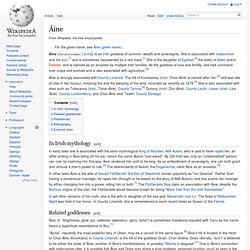
She is associated with midsummer and the sun,[1] and is sometimes represented by a red mare.[1] She is the daughter of Egobail,[2] the sister of Aillen and/or Fennen, and is claimed as an ancestor by multiple Irish families. As the goddess of love and fertility, she had command over crops and animals and is also associated with agriculture.[2] Áine is strongly associated with County Limerick. The hill of Knockainey (Irish: Cnoc Áine) is named after her,[2] and was site of rites in her honour, involving fire and the blessing of the land, recorded as recently as 1879.[3] She is also associated with sites such as Toberanna (Irish: Tobar Áine), County Tyrone;[4] Dunany (Irish: Dun Áine), County Louth; Lissan (Irish: Lios Áine), County Londonderry; and Cnoc Áine near Teelin, County Donegal.
In Irish mythology[edit] Related goddesses[edit] References[edit] Bibliography[edit] Alaunus. The etymology of the name has never been ascertained and authorities differ over their interpretation.
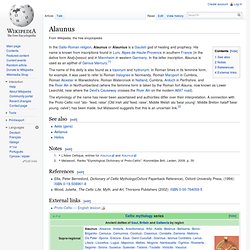
A connection with the Proto-Celtic root *alo- 'feed, raise' (Old Irish alid 'feed, raise', Middle Welsh alu 'bear young', Middle Breton halaff 'bear young, calve') has been made, but Matasović suggests that this is an uncertain link.[2] See also[edit] Notes[edit] Jump up ^ L'Arbre Celtique, entries for Alaunus and Alaunius.Jump up ^ Matasović, Ranko "Etymological Dictionary of Proto-Celtic". Kloninklijke Brill, Leiden, 2009. p. 30 References[edit] Albina (mythology) Albina was an Etruscan goddess of the dawn and protector of ill-fated lovers.
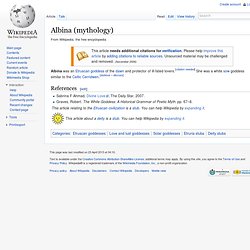
[citation needed] She was a white sow goddess similar to the Celtic Cerridwen. Apollo. Baldr. "Each arrow overshot his head" (1902) by Elmer Boyd Smith.
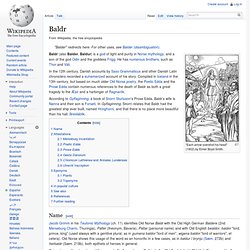
Baldr (also Balder, Baldur) is a god of light and purity in Norse mythology, and a son of the god Odin and the goddess Frigg. He has numerous brothers, such as Thor and Váli. In the 12th century, Danish accounts by Saxo Grammaticus and other Danish Latin chroniclers recorded a euhemerized account of his story. Beaivi. Beaivi is the spring and sun goddess of fertility and sanity was worshipped by the Sami, one of the indigenous peoples of Fennoscandia.

At Winter solstice a white female reindeer was sacrificed in honour of Beivve, to ensure that she returned to the world and put an end to the long winter season. At the time of the year when the Sun was returning, butter (which melts in the sunshine) was smeared on the doorposts, as a sacrifice to Beivve, so that she could gain strength during her convalescence and go higher and higher in the sky. At Summer solstice, people made sun-rings out of leaves and pinned them up in her honour. At these occasions, they also ate butter as a sacral meal. Beivve was often accompanied by her daughter, Beaivi-nieida (the sun maiden) in an enclosure of reindeer antlers. Belenus. In Celtic mythology, Bel, Belenos (also Belenus) was a deity worshipped in Gaul, Cisalpine Gaul, and Celtic areas of Austria, Britain and Spain.

He is particularly associated with Cornwall, West Cornwall being anciently called Belerion, the place of Bel. He was the Celtic sun god and had shrines from Aquileia on the Adriatic to Kirkby Lonsdale in England.[1][2] The etymology of the name is unclear. Suggestions include "shining one,"[3] "the bright one"[4] and "henbane god".[5] In the Roman period he was identified with Apollo.[1] There are currently 51 known inscriptions dedicated to Belenus, mainly concentrated in Aquileia and Cisalpine Gaul, but also extend into Gallia Narbonensis, Noricum, and far beyond.[4] Images of Belenus sometimes show him to be accompanied by a female, thought to be the Gaulish deity Belisama.[4] Belobog. Belobog, Bilobog, Belbog, Bialbog, Byelobog, Bielobog, Belun or Bylun (all names meaning White God) is a reconstructed Slavic deity of light and Sun, the counterpart of dark and cursed Chernobog (Black God).
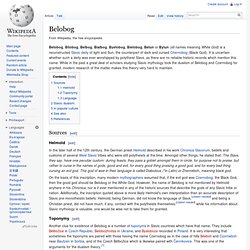
It is uncertain whether such a deity was ever worshipped by polytheist Slavs, as there are no reliable historic records which mention this name. While in the past a great deal of scholars studying Slavic mythology took the dualism of Belobog and Czernobog for granted, modern research of the matter makes this theory very hard to maintain. Dagr. In Norse mythology, Dagr (Old Norse "day"[1]) is day personified.

Dažbog. Dažbog (Proto-Slavic: *dadjьbogъ,[1] Serbo-Croatian: Dabog, Daždbog, Dajbog; Bulgarian: Даждбог, Polish: Dadźbóg, Russian: Даж(д)ьбог, Ukrainian: Дажбог), alternatively Dazhbog, Dajbog, Dazhdbog, or Dadzbóg, was one of the major gods of Slavic mythology, most likely a solar deity and possibly a cultural hero.
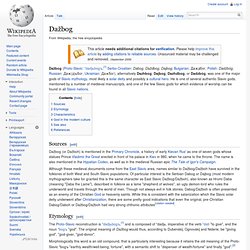
He is one of several authentic Slavic gods, mentioned by a number of medieval manuscripts, and one of the few Slavic gods for which evidence of worship can be found in all Slavic nations. Sources[edit] Eki. Eki (also Eguzki, Iuski, Iguzki, Iduzki or Eguzku) are the names of the Sun in the Basque language.
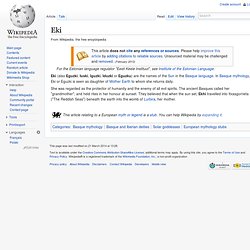
In Basque mythology, Eki or Eguzki is seen as daughter of Mother Earth to whom she returns daily. She was regarded as the protector of humanity and the enemy of all evil spirits. The ancient Basques called her "grandmother"; and held rites in her honour at sunset. Endovelicus. Endovelicus (also Endouellicus, Endovélico in Portuguese), was an Iron Age god of public health and safety, worshipped in pre-Roman and Roman Lusitania and Gallaecia.
He was associated with chthonic oracles and healing, and was probably the recipient of pig sacrifices. After the Roman invasion, his cult spread to most of the Roman Empire, but was always most popular in the Roman provinces of Lusitania (covering part of what is now Portugal) and Betica (located in Southern Spain). Thus he is considered part of the Roman mythology and the related Lusitanian and Gallaecian mythology. Eos. Etymology[edit] Greek literature [edit] Electryone. It is speculated by some that she was possibly a goddess of the morning, or of man's waking sense, which causes him to wake up in the morning; the Doric form of her name is akin to the Greek word for "rooster" (Alectrona, the feminine genitive of Αλεκτορ, Alektor, the Greek word for "rooster"), while the Greek form Electryone is akin to the word for "amber" (Ἠλέκτρα, Elektra), as in the amber color of sunrise (as opposed to sunset, implied by Helios being her father); naturally, either of which would be an appropriate name for a solar goddess.
A marble tablet from the 3rd century BC found in Ialyssus contains an inscription about the regulations for visitors to the temple of Alectrona.[2] Notes[edit] Étaín. Étaín (modern spelling: Éadaoin) is a figure of Irish mythology, best known as the heroine of Tochmarc Étaíne (The Wooing Of Étaín), one of the oldest and richest stories of the Mythological Cycle. She also figures in the Middle Irish Togail Bruidne Dá Derga (The Destruction of Da Derga's Hostel). T. F. O'Rahilly identified her as a sun goddess. Freyr. Freyr (sometimes anglicized Frey, from *frawjaz "lord"[1]) is one of the most important gods of Norse paganism.
Grannus. Name[edit] Helios. Names[edit] Heracles. Origin and character Heracles was the greatest of Hellenic chthonic heroes, but unlike other Greek heroes, no tomb was identified as his. Heracles was both hero and god, as Pindar says heroes theos; at the same festival sacrifice was made to him, first as a hero, with a chthonic libation, and then as a god, upon an altar: thus he embodies the closest Greek approach to a "demi-god".[8] The core of the story of Heracles has been identified by Walter Burkert as originating in Neolithic hunter culture and traditions of shamanistic crossings into the netherworld.[9] Hero or god Heracles' role as a culture hero, whose death could be a subject of mythic telling (see below), was accepted into the Olympian Pantheon during Classical times. Hors. Hyperion (mythology) Hyperion's son Helios was referred to in early mythological writings as Helios Hyperion (Ἥλιος Ὑπερίων, "Sun High-one").
Koyash. Lugh. 1905 illustration of Lugh's bloodthirsty magical spear by H. R. Millar. Mug Ruith. Mug Ruith (or Mogh Roith, "slave of the wheel") is a figure in Irish mythology, a powerful blind druid of Munster who lived on Valentia Island, County Kerry. He could grow to enormous size, and his breath caused storms and turned men to stone. He wore a hornless bull-hide and a bird mask, and flew in a machine called the roth rámach, the "oared wheel". He had an ox-driven chariot in which night was as bright as day, a star-speckled black shield with a silver rim, and a stone which could turn into a poisonous eel when thrown in water. Stories about Mug Ruith are set in various periods of Irish history. Some say he lived during the reign of 3rd century High King Cormac mac Airt, while others put him in Jerusalem during the time of Christ.
Neto (deity) Phanes (mythology) Radegast (god) Saulė. Sol (mythology) Sulis. Theia. Thesan. Zorya.